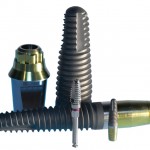
An alternative to bone grafting and short implants following the loss posterior teeth and alveolar bone is the use of tilted implants.
The aim of this review was to compare the survival rate of dental implants, postoperative infection, and marginal bone loss of tilted and axially placed dental implants.
Methods
Searches were conducted in the PubMed, Web of Science, the Cochrane Oral Health Group Trials Register together with the trials in progress registers clinicaltrials.gov; www.centerwatch.com/clinical-trials; www.clinicalconnection.com. Human clinical studies whether or not randomised, interventional or observational that compared implant failure rates in any group of patients receiving tilted or axially placed dental implants.
There reviewers independently selected studies for inclusion with study quality being assessed using the Newcastle-Ottawa scale (NOS). The main outcomes considered were implant failure and postoperative infection.
Results
- 44 studies were included, 25 prospective studies, 19 retrospective studies.
- 36 studies were considered to be of high quality, 8 of moderate quality.
- The 44 studies included 5029 tilted implants and 5732 axially placed implants.
- There were 82 failures of tilted implants (1.63%) and 104 axially placed implants (1.81%)
- Insertion of dental implants in a tilted position did not statistically affect the implant failure rates RR = 1.14, (95% CI, 0.84–1.56, P = 0.40)
- There was a statistically significant difference for implant failures inserted in maxillae only were pooled (RR 1.70, 95% CI 1.05-2.74; P=0.03), But not in the mandible (RR 0.77, 95% CI 0.39-1.52; P=0.45).
- There were no apparent significant effects of tilted dental implants on the occurrence of marginal bone loss (MD 0.03, 95% CI -0.03 to 0.08; P=0.32).
- Meta-analysis for the outcome ‘postoperative infection’ was not performed due to lack of data.
Conclusions
The authors concluded
The results of the present review should be interpreted with caution due to the presence of uncontrolled confounding factors in the included studies, none of them randomised. Within the limitations of the existing investigations, the present study suggests that the differences in angulation of dental implants in relation to the mesial–distal occlusal plane might not affect the survival of these dental implants or the marginal bone loss. A statistically significant difference was found for implant failures when studies evaluating implants inserted in maxillae only were pooled, in favour of axially placed implants. The same was not true for implants inserted in mandibles.
Commentary
This is one of a series of reviews of dental implant related questions that have been published by this group of authors (see links). No randomised controlled trials have been identified and the authors have chosen to include both pro- and retrospective studies. Although a large number of the studies were considered to be of high quality. It would have been interesting to see the impact of sensitivity analysis restricting the meta-analysis to prospective studies. The authors themselves raise the issues of accounting for potential confounders which high quality randomised controlled trials would help to overcome. The authors also point out that many of the studies involve only a small number of patients ranging from (15 -245). Therefore although the available evidence suggests that there is no difference in survival between tilted and axially placed implants the findings of this review should be treated with caution.
Links
Chrcanovic BR, Albrektsson T, Wennerberg A. Tilted versus axially placed dental implants: A meta-analysis. J Dent. 2014 Sep 17. pii: S0300-5712(14)00261-9. doi: 10.1016/j.jdent.2014.09.002. [Epub ahead of print] Review. PubMed PMID: 25239770
Dental Elf – 8th July 2014 – Dental implants placement flapless or not?

Don’t miss – Dental implants: are survival rates for tilted and axially placed implants similar? http://t.co/PCoXCy6UG8
[…] Dental Elf- 5th Dec 2014 – Dental implants: are survival rates for tilted and axially placed i… […]